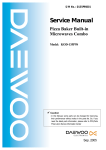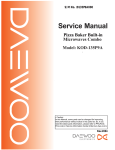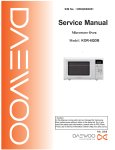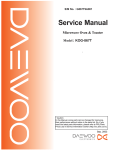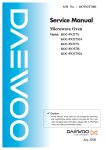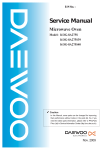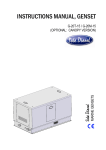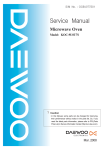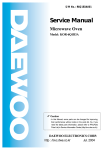Download Daewoo KOR-6Q4R5S Service manual
Transcript
S/M No. :G6C4R5S001 Service Manual Microwave Oven Model: KQG-6C4R5S KQG-6C5R5S ✔ Caution : In this Manual, some parts can be changed for improving, their performance without notice in the parts list. So, if you need the latest parts information, please refer to PPL(Parts Price List) in Service Information Center . Apr. 2005 PRECAUTIONS TO BE OBSERVED BEFORE AND DURING SERVICING TO AVOID POSSIBLE EXPOSURE TO EXCESSIVE MICROWAVE ENERGY (a) Do not operate or allow the oven to be operated with the door open. (b) Make the following safety checks on all ovens to be serviced before activating the magnetron or other microwave source, and make repairs as necessary: (1) Interlock operation, (2) Proper door closing, (3) Seal and sealing surfaces (arcing, wear, and other damage), (4) Damage to or loosening of hinges and latches, (5) Evidence of dropping or abuse. (c) Before turning on power to the microwave oven for any service test or inspection within the microwave generating compartments, check the magnetron, wave guide or transmission line, and cavity for proper alignment, integrity, and connections. (d) Any defective or misadjusted components in the interlock, monitor, door seal, and microwave generation and transmission systems shall be repaired, replaced, or adjusted by procedures described in this manual before the oven is released to the owner. (e) A microwave leakage check to verify compliance with the Federal performance standard should be performed on each oven prior to release to the owner. TABLE OF CONTENTS SAFETY AND PRECAUTIONS....................................................................................................................................................................2 SPECIFICATIONS .........................................................................................................................................................................................3 EXTERNAL VIEW (KQG-6C4R5S)..............................................................................................................................................................4 INSTALLATION .............................................................................................................................................................................................8 OPERATIONS AND FUNCTIONS...............................................................................................................................................................9 DISASSEMBLY AND ASSEMBLY............................................................................................................................................................10 INTERLOCK MECHANISM AND ADJUSTMENT...................................................................................................................................20 TROUBLESHOOTING GUIDE...................................................................................................................................................................21 MEASUREMENT AND TEST.....................................................................................................................................................................25 1. MEASUREMENT OF THE MICROWAVE POWER OUTPUT........................................................................25 2. MICROWAVE RADIATION TEST ..................................................................................................................26 3. COMPONENT TEST PROCEDURE ..............................................................................................................27 WIRING DIAGRAM......................................................................................................................................................................................28 PRINTED CIRCUIT BOARD.......................................................................................................................................................................29 1. CIRCUIT CHECK PROCEDURE....................................................................................................................29 2. P.C.B. CIRCUIT DIAGRAM ............................................................................................................................34 3. P.C.B. LOCATION NO....................................................................................................................................35 EXPLODED VIEW AND PARTS LIST ......................................................................................................................................................36 1 SAFETY AND PRECAUTIONS 1. FOR SAFE OPERATION Damage that allows the microwave energy (that cooks or heats the food) to escape will result in poor cooking and may cause serious bodily injury to the operator. IF ANY OF THE FOLLOWING CONDITIONS EXIST, OPERATOR MUST NOT USE THE APPLIANCE. (Only a trained service personnel should make repairs.) (1) A broken door hinge. (2) A broken door viewing screen. (3) A broken front panel, oven cavity. (4) A loosened door lock. (5) A broken door lock. The door gasket plate and oven cavity surface should be kept clean. No grease, soil or spatter should be allowed to build up on these surfaces or inside the oven. DO NOT ATTEMPT TO OPERATE THIS APPLIANCE WITH THE DOOR OPEN. The microwave oven has concealed switches to make sure the power is turned off when the door is opened. Do not attempt to defeat them. DO NOT ATTEMPT TO SERVICE THIS APPLIANCE UNTIL YOU HAVE READ THIS SERVICE MANUAL. 2. FOR SAFE SERVICE PROCEDURES 1. If the oven is operative prior to servicing, a microwave emission check should be performed prior to servicing the oven. 2. If any certified oven unit is found to servicing, a microwave emission check should be performed prior to servicing the oven. (a) inform the manufacturer, importer or assembler, (b) repair the unit at no cost to the owner, (c) attempt to ascertain the cause of the excessive leakage, (d) tell the owner of the unit not to use the unit until the oven has been brought into compliance. 3. If the oven operates with the door open, the service person should tell the user not to operate the oven and contact the manufacturer and CDRH immediately. IMPORTANT The wire in this mains lead coloured in accordance with the following code. Green-and-yellow : Earth Blue : Neutral Brown : Live As the colours of the wires in the manins lead of this appliance may not correspond with the coloured markings identifying the terminals in your plug, proceed as follows. The wire which is coloured green-and-yellow must be connected to the terminal in the plug which is marked with the letter ‘E’, earth symbol or coloured green-and-yellow. The wire which is coloured blue must be connected to the terminal which is marked with the letter ‘N’ or coloured black. The wire which is coloured brown must be connected to the terminal which is marked with the letter ‘L’ or coloured red. NOTE : The oven is designed for counter-top use only. 2 SPECIFICATIONS MODEL KQG-6C4R5S / KQG-6C5R5S POWER SUPPLY POWER CONSUMPTION 230V~50Hz, SINGLE PHASE WITH EARTHING MICROWAVE 1200 W GRILL 1050 W COMBINATION 2200 W MICROWAVE ENERGY OUTPUT 800W MICROWAVE FREQUENCY 2450MHz OUTSIDE DIMENSIONS (WXHXD) 465X279X384mm CAVITY DIMENSIONS (WXHXD) 290X220X306mm NET WEIGHT APPROX. 13.7Kg TIMER 60 min. 00 sec. POWER SELECTIONS 10 LEVELS CAVITY VOLUME 0.7 Cu.Ft. * SPECIFICATIONS ARE SUBJECT TO CHANGE WITHOUT NOTICE. 3 EXTERNAL VIEW (KQG-6C4R5S) 1. OUTER DIMENSION 2. FEATURE DIAGRAM 1 Door seal - Door seal maintains the microwave energy within the oven cavity and prevents microwave leakage. 8 Roller guide - This must always be used for cooking together with the glass cooking tray. 2 Cover Heater 9 Glass cooking tray - Made of special heat resistant glass. Food in a proper receptacle is placed on this tray for cooking. 3 Heating Element 4 Oven cavity 0 Door viewing screen - Allows viewing of food. The screen is designed so that light can pass through, but not the microwave. 5 Safety interlock system 6 Metal Rack q Door hook - When the door is closed, it will automatically shut off. If the door is opened while the oven is operating, the magnetron will immediately stop operating. 7 Coupler - This fits over the shaft in the center of the ovens cavity floor. This is to remain in the oven for all cooking. 4 EXTERNAL VIEW (KQG-6C5R5S) 1. OUTER DIMENSION 2. FEATURE DIAGRAM 1 Door seal - Door seal maintains the microwave energy within the oven cavity and prevents microwave leakage. 8 Roller guide - This must always be used for cooking together with the glass cooking tray. 2 Cover Heater 9 Glass cooking tray - Made of special heat resistant glass. Food in a proper receptacle is placed on this tray for cooking. 3 Heating Element 4 Oven cavity 0 Door viewing screen - Allows viewing of food. The screen is designed so that light can pass through, but not the microwave. 5 Safety interlock system 6 Metal Rack q Door hook - When the door is closed, it will automatically shut off. If the door is opened while the oven is operating, the magnetron will immediately stop operating. 7 Coupler - This fits over the shaft in the center of the ovens cavity floor. This is to remain in the oven for all cooking. 5 3. CONTROL PANEL (KQG-6C4R5S) y w r a e s p d t i u o w Auto cook - Used to cook using a program or to reheat. i Start/Express cook - Used to start the oven operation and also increase the reheat time by 30 seconds. e Micro Power - Used to set power level. o Dial knob - Used to set the time and weight. r Auto Defrost - Used to defrost foods by weight. p Quick Defrost - Used to defrost food very Quickly. t Clock - Used to set clock. a Chilled Meal - Used to reheat the meal. y Display - Cooking time, power level, indicators and present time are displayed. s Frozen Meal - Used to reheat the meal. d Grill/Combi -Used to cook grill/combi. u Stop/Clear - Used to stop the oven operation or to erase all entries. 6 (KQG-6C5R5S) y r w e a p s t d o u i w Auto cook - Used to cook using a program or to reheat. i Start/Express cook - Used to start the oven operation and also increase the reheat time by 30 seconds. e Micro Power - Used to set power level. o Dial knob - Used to set the time and weight. r Auto Defrost - Used to defrost foods by weight. p Quick Defrost - Used to defrost food very Quickly. t Clock - Used to set clock. a Chilled Meal - Used to reheat the meal. y Display - Cooking time, power level, indicators and present time are displayed. s Frozen Meal - Used to reheat the meal. u Stop/Clear - Used to stop the oven operation or to erase all entries. d Grill/Combi -Used to cook grill/combi. 7 INSTALLATION 1. Steady, flat location This microwave oven should be set on a steady, flat surface. This microwave oven is designed for counter top use only. 2. Leave space behind and side All air vents should be kept a clearance. If all vents are covered during operation, the oven may overheat and, eventually, cause oven failure. 3. Away from Radio and TV sets Poor television reception and radio interference may result if the oven is located close to a TV, Radio, antenna or feeder and so on. 4. Away from heating appliances and water taps Keep the oven away from hot air, steam or splash when choosing a place to position it, or the insulation might be adversely affected and breakdowns occur. 5. Power supply ➢ Check your local power source. This microwave oven requires a current of approximately 10 amperes, 230Volts, 50Hz grounded outlet. ➢ Power supply cord is about 0.8 meters long. ➢ The voltage used must be the same as specified on this oven. Using a higher voltage may result in a fire or other accident causing oven damage. Using low voltage will cause slow cooking, We are not responsible for damage resulting from use of this oven with a voltage of ampere fuse other than those specified. ➢ This appliance is supplied with cable of special type, which, if samaged, must be repaired with cable of same type. Such a cable can be purchased from DAEWOO and must be installed by a Qualified Person. 6. Examine the oven after unpacking for any damage such as: A misaligned door, broken door or a dent in cavity. If any of the above are visible, DO NOT INSTALL, and notify dealer immediately. 7. Do not operate the oven if it is colder than room temperature (This may occur during delivery in cold weather.) Allow oven to become room temperature before operating. EARTHING INSTRUCTIONS This appliance must be earthed. In the event of an electrical short circuit, earthing reduces the risk of the electric shock by providing an escape wire for the electric current. This appliance is equipped with a cord having a earthing wire with a earthing plug. The plug must be plugged into an outlet that is properly installed ant earthed. WARNING Improper use of the earthing plug can result in a risk of electric shock. Consult a qualified electrician or serviceman if the earthing instructions are not completely understood, or if doubt exists as to whether the appliance is properly earthed, and either:If it is necessary to use an extension cord, use only a 3-wire extension cord that has a 3-blade earthing plug, and a 3-slot receptacle that will accpt the plug on the appliance. The marked rating of the extension cord should be equal to or greater than the electrical rating of the appliance, or Do not use an extension cord. 8 OPERATIONS AND FUNCTIONS This section includes useful information about oven operation. the STOP/CLEAR is pressed during the oven operation, 1 Plug power supply cord into 230V AC 50Hz power outlet. 8 When the oven stops cooking and all information retained. To erase placing the food in a suitable container, open the all information(except the present time), press the 2 After oven door and put it on the glass tray. STOP/CLEAR once more. If the oven door is opened during The glass tray and roller guide must always be in place during cooking. 3 oven door can be opened at any time during operation 4 The by pulling the door. The oven will automatically shut off. To Close the door. Make sure that it is firmly closed. the oven operation, all information is retained. oven will not start cooking until the door is completely 9 The closed or the program has been reset. NOTE : When using the GRILL or COMBI mode; • Do not open the door so often, the temperature inside the oven decrease and the cooking may not be completed in setting time. • Never touch the oven window and metal interior of the oven when taking food in and out, because the temperature inside the oven and door is very high. • When using these modes, be careful as the tray will be hot to touch, use oven gloves or pot holders while handling tray. restart the oven, close the door and then press START. oven automatically cooks on full power unless set to 5 The a lower power level. 6 The display will show “ : 0” when the oven is plugged in. clock returns to the present time when the cooking 7 Time time ends. Make sure the oven is properly installed and plugged into the electrical outlet. WATTAGE OUTPUT CHART • The power-level is set by pressing the Power button. The chart shows the display, the power level and the percentage of power. Press Power button Power level (Display) Approximate Percentage of Power once P-HI 100% twice P-90 90% 3 times P-80 80% 4 times P-70 70% 5 times P-60 60% 6 times P-50 50% 7 times P-40 40% 8 times P-30 30% 9 times P-20 20% 10 times P-10 10% 11 times P-00 0% 9 DISASSEMBLY AND ASSEMBLY Cautions to be observed when trouble shooting. Unlike many other appliances, the microwave oven is high-voltage, high-current equipment. It is completely safety during normal operation. However, carelessness in servicing the oven can result in an electric shock or possible danger from a short circuit. You are asked to observe the following precautions carefully. 1. Always remove the power plug from the outlet before servicing. 2. Use an insulated screwdriver and ware rubber gloves when servicing the high voltage side. 3. Discharge the high voltage capacitor before touching any oven components or wiring. (1) Check the grounding. Do not operate on a 2-wire extension cord. The microwave oven is designed to be used with grounded. It is imperative, therefore, to make sure it is grounded properly before beginning repair work. (2) Warning about the electric charge in the high voltage capacitor. For about 30 seconds after the operation stopped and electric charge remains in the high voltage capacitor. When replacing or checking parts, short between oven chassis and the negative high terminal of the high voltage capacitor, by using a properly insulated screwdriver to discharge. 4. When the 15A fuse is blown out due to the operation of the monitor switch; replace primary interlock switch, secondary interlock switch and interlock monitor switch. 5. After repair or replacement of parts, make sure that the screws are properly tightened, and all electrical connections are tightened. 6. Do not operate without cabinet. SHORT CAUTION : Service personnel should remove their watches whenever working close to or replacing the magnetron. CAUTION : When servicing the appliance, need a care of touching or replacing high potential parts because of electrical shock or exposing microwave. These parts are as follows - HV Transformer, Magnetron, HV Capacitor, HV Diode, HV fuse. 10 1. To remove cabinet 1) Remove three screws on cabinet back. 2) Push the cabinet backward. 2. To remove door assembly 1) Remove a screws which secure the stopper hinge top. 2) Remove the door assembly from top plate of cavity. 3) Reverse the above for reassembly. NOTE : After replacing the door assembly, perform a check of correct alignment with the hinge and cavity front plate. 11 3. To remove door parts. REF NO. PART CODE PART NAME DESCRIPTION Q'TY A01 3511614900 DECORATOR DOOR AS KOR-6Q4R5S 1 A02 3512209000 FRAME DOOR ABS SG-0760D SG-175 1 A03 3517009100 BARRIER-SCREEN *O SAN CR-5381 SMOG 1 A04 3515204100 STOPPER HINGE *T AS KOR-63150S 1 A05 3511719500 DOOR PAINTING AS KOR-6C0B5S 1 A06 3517002800 BARRIER-SCREEN *I POLYESTER T0.1 1 A07 3512300210 GASKET DOOR PP 1 A08 3513100730 HOOK POM BLACK 1 A09 3515101320 SPRING HOOK HSW-3 1 A10 3513100730 SCREW TAPPING T2S TRS 4X12 MFZN 2 HANDLE DOOR ABS SG-0760D SG-175 A11 3512605610 3512605640 (1) Remove the gasket door from door weld as. (2) Remove the barrier screen inner from door weld as. (3) Remove the door frame from door weld as. (4) Remove the stopper hinge top from door weld as. (5) Remove the spring and the hook. (6) Remove the barrier screen outer from door frame. (7) Remove the decorator door from door frame. (8) Reverse the above steps for reassembly. 12 REMARK 1 KOR-6Q4R5S 1 KOR-6Q5R5S 4. Method to reduce the gap between the door seal and the oven front surface. (1) To reduce gap located on part ‘A’ • Loosen two screws on stopper hinge top, and then push the door to contact the door seal to oven front surface. • Tighten two screws. (2) To reduce gap located on part ‘B’. • Loosen three screws on bottom hinge, and then the door to contact the door seal to oven front surface. • Tighten three screws. NOTE: A small gap may be acceptable if the microwave leakage does not exceed 4m W/cm2. 13 5. To remove control panel parts. (KQG-6C4R5S) REF NO. PART CODE PART NAME DESCRIPTION Q’TY B01 3513408400 KNOB VOLUME ABS SG-175 SG-0760D 1 B02 3515501550 WINDOW DISPLAY SAN CR-5381 SMOG 1 B03 3511614200 DECORATOR C-PANEL STS430 T0.5 H/L 1 B04 3516732300 CONTROL-PANEL ABS SG-175 SG-0760D 1 B05 3516913500 BUTTON FUNCTION-B ABS SG-175 SG-0760D 2 B06 3516913400 BUTTON FUNCTION-A ABS SG-175 SG-0760D 1 B07 PKBPMSBD00 PCB BUTTON MANUAL AS KOR-6Q4R5S 1 B08 PKMPMSBD50 PCB MAIN MANUAL AS KQG-6C4R5S 1 B09 7122401211 SCREW TAPPING T2S TRS 4X12 MFZN 4 B10 7621301011 SCREW TAPPING T2 PAN 3X10 PW MFZN 4 REMARK 1) Remove the screw which secure the control panel, push up two snap fits and draw forward the control panel assembly. 2) Remove screws which secure the PCB assembly to control panel. 3) Disconnect membrane tail from the connector of the PCB assembly. 4) Detach the function buttons and knob from the control panel. 5) Reverse the above steps for reassembly. 14 (KQG-6C5R5S) REF NO. PART CODE PART NAME DESCRIPTION Q’TY B01 3513408420 KNOB VOLUME ABS SG-175 SG-0760D 1 B02 3515502400 WINDOW DISPLAY SAN CR-5381 SMOG 1 B03 3511614200 DECORATOR C-PANEL STS430 T0.5 H/L 1 B04 3516732350 CONTROL-PANEL ABS SG-175 SG-0760D 1 B05 3516913520 BUTTON FUNCTION-B ABS SG-175 SG-0760D 2 B06 3516913420 BUTTON FUNCTION-A ABS SG-175 SG-0760D 1 B07 PKBPMSF100 PCB BUTTON MANUAL AS KOR-6Q4R5S 1 B08 PKMPMSF150 PCB MAIN MANUAL AS KQG-6C4R5S 1 B09 7122401211 SCREW TAPPING T2S TRS 4X12 MFZN 4 B10 7621301011 SCREW TAPPING T2 PAN 3X10 PW MFZN 4 REMARK 1) Remove the screw which secure the control panel, push up two snap fits and draw forward the control panel assembly. 2) Remove screws which secure the PCB assembly to control panel. 3) Disconnect membrane tail from the connector of the PCB assembly. 4) Detach the function buttons and knob from the control panel. 5) Reverse the above steps for reassembly. 15 6. To remove high voltage capacitor. 1) Remove a screw which secure the grounding ring terminal of the H.V. diode and the capacitor holder. 2) Remove the H.V. diode from the capacitor holder. 3) Reverse the above steps for reassembly. ◆ High voltage circuit wiring 7. To remove magnetron. 1) Remove a screw which secure the magnetron. 2) Remove the magnetron. 3) Reverse the above steps for reassembly. NOTE : Never install the magnetron without the metallic gasket plate which is packed with each magnetron to prevent microwave leakage. Whenever repair work is carried out on magnetron, check the microwave leakage. It shall not exceed 4mW/cm2 for a fully assembled oven with door normally closed. 16 8. To remove wind guide assembly. 1) Remove a screw for earthing. 2) Remove the noise filter from the wind guide. 3) Remove a screw which secure the wind guide assembly. 4) Draw forward the wind guide assembly. 5) Pull the fan from the motor shaft. 6) Remove two screws which secure the motor shaded pole. 7) Remove the motor shaded pole. 8) Reverse the above steps for reasembly. 9. To remove H.V.transformer. 1) Remove four screws holding the H.V.transformer. 2) Remove the H.V.transformer. 3) Reverse the above steps for reassembly. 17 10. To remove tray motor 1) Remove the coupler in the cavity. 2) Turn the set upside down. 3) Cut the tray motor cover part from the base plate. 4) Remove the tray motor cover. 5) Remove a screw which secure the tray motor. 6) Remove the tray motor. 7) Reverse the above steps for reassembly except for securing the tray motor cover with screw. 11. To remove heater assembly 1) Remove one side of the heater harness. 2) Remove a screw which secure the cover insulator top. 3) Remove the cover insulator top. 4) Remove the heater top assembly. 5) Reverse the above steps for reassembly. 18 ✔ Caution : In this Manual, some parts can be changed for improving, their performance without notice in the parts list. So, if you need the latest parts information, please refer to PPL(Parts Price List) in Service Information Center (http://svc.dwe.co.kr). 12. To remove heater parts C01 C02 C03 C04 C05 HEATER TOP ASSEMBLY : 3512803600 REF NO. PART CODE PART NAME DESCRIPTION C01 3512765100 HARNESS HEATER KOC-970T1S TEFLON 1 C02 7112401011 SCREW TAPPING T1 TRS 4X10 MFZN 2 C03 3510607800 BRACKET HEATER *T SBHG T0.5 2 C04 3512803700 HEATER MIRACLON 115V AC 500W 2 C05 3511408100 COVER HEATER *T STS430 T0.5 1 19 Q’TY REMARK INTERLOCK MECHANISM AND ADJUSTMENT The door lock mechanism is a device which has been specially designed to completely eliminate microwave radiation when the door is opened during operation, and thus to perfectly prevent the danger resulting from the leakage of microwave. (1) Primary interlock switch When the door is closed, the hook locks the oven door. If the door is not closed properly, the oven will not operate. When the door is closed, the hook pushes the button of the microswitch. Then the button of the primary interlock switch bring it under ON condition. (2) Secondary interlock switch and interlock monitor switch When the door is closed, the hook pushes the lock lever downward. The lock lever presses the button of the interlock monitor switch to bring it under NO condition and presses the button of the secondary interlock switch to bring it under ON condition. ADJUSTMENT : Interlock monitor switch When the door is closed, the interlock monitor switch should be changed (NO condition) before other switches are closed. When the door is opened, the interlock monitor switch should be changed (NC condition) after other switches are opened. (3) Adjustment steps a) Loosen the one mounting screw. b) Adjust interlock switch assembly position. c) Make sure that lock lever moves smoothly after adjustment is completed. d) Tighten completely two mounting screws. NOTE : Microwave emission test should be performed after adjusting interlock mechanism. If the microwave emission exceed 4mW/cm2, readjust interlock mechanism. 20 TROUBLESHOOTING GUIDE Following the procedure below to check if the oven is defective or not. 1) Check earthing before trouble checking. 2) Be careful of the high voltage circuit. 3) Discharge the high voltage capacitor. 4) When checking the continuity of the switches, fuse or high voltage transformer, disconnect one lead wire from these parts and check continuity with the AC plug removed. To do otherwise may result in a false reading or damage to your meter. NOTE When electric parts are checked, be sure the power cord is not inserted the wall outlet. Check wire hamess, wiring and connected of the terminals and power cord before check the parts listed below. (TROUBLE 1) Oven does not operate at all : any inputs can not be accepted. CONDITION Fuse blows. CHECK RESULT Check continuty of interlock monitor switch with door closed (COM ↔ NC) Continuity CAUSE Malfunction of interlock monitor switch REMEDY Replace NOTE 1 No Continuity Check continuity of both primary and secondary interlock switch with door colosed No Continuity Continuity Continuity Check continuity of primary interlock switch contact with door partially open until interlock monitor switch contact close (COM ÷ NC) 0Ω or infinite Check continuity of primary winding of low voltage transformer Approx. 150~310 (normal) Disconnect high voltage fuse and operate the unit Fuse again blows 21 Replace Malfunction of interlock switch Shorted contacts of primary interlock switch. Defective low voltage transformer Defective high voltage transformer NOTE 1 Replace NOTE 1 Replace Replace CONDITION Outlet has proper voltage Fuse does not blow. CHECK RESULT CAUSE REMEDY No Continuity Defective magnetron Replace Check continuity of magnetron Check continuity of noise filter board No Continuity Defective line filter board Replace Check continuity of power supply cord No Continuity Open power supply cord Replace Normal Defective touch control circuit Replace NOTE Akk these switches must be replaced at the same time, please refer to "Interlock Mechanism And Adjustment". (TROUBLE 2) Display shows all figures selected, but oven does not start cooking, even though desired program and time are set and start pad is tapped. CONDITION Turn table motor and oven lamp do not turn on CHECK RESULT CAUSE REMEDY Check continuity of primary interlock switch No Continuity Malfunction of primary interlock switch Adjust or replace Check continuity of secondary interlock and D.O.M. switches No Continuity Malfunction of primary interlock and D.O.M. switch Adjust or replace 0V Check D.C. voltage being supplied to RELAY (RY2) coil Approx. 15 VDC 22 Defective touch control circuit Faulty contacts of RELAY (RY2) or open relay coil Replace Replace (TROUBLE 3) No microwave oscillation even though fan motor rotates. CONDITION CHECK RESULT No microwave oscillation Check continuity of high voltage fuse No Continuity CAUSE REMEDY Replace high voltage fuse Check continuity if high voltage capacitor terminals with wires removed Continuity Defective high voltage transformer Replace Check continuity of high voltage rectifier in forward and backward direction with DC megger Continuity in backward direction Defective high voltage rectifier Replace Connect megger leads to magnetron terminal and magnetron body Continuity Defective magnetron Replace Defective high voltage transformer Replace 0 Ω or ∞ Check resistance of primary and secondary coil of high voltage transformer No Continuity Check continuity of magnetron with wires removed No Continuity Check continuity of filament terminal of high voltage transformer Defective magnetron Defective high voltage transformer 0V Check D.C. voltage being supplied to RELAY (RY1) coil Defective touch control circuit Approx 15 VDC 23 Faulty contacts or RELAY (RY1) or open relay coil Replace Replace Replace Replace (TROUBLE 4) The following visual conditions inditions indicate a probable defective touch control circuit or membrane switch assembly 1. Incomplete segments, 1) Segments missing. 2) Partical segments missing. 3) Digit flickering other than normal display slight flickering. 4) " :0" does not display when power is on. 2. A distinct change in the display are not on when they numbers is the display. 3. One or more digits in the display are not on when they should be. 4. Display indicates a number different from one touched. 5. Specific numbers (for example 2 or 3) will not display when the panel is touched. 6. Display does not count down or up with time cooking or clock operation. 7. Oven is programmable and cooks normally but no display shows. 8. Display obviously jumps in time while counting down. 9. Display counts down noticeable too fast while cooking. 10. Display does not show the time of day when dlear pad is touched. 11. Oven lamp and turntable motor do not stop although cooking is finished. Check if the TELAY 2 contacts close if they are close, replace touch control circuit. CONDITION CHECK Display does not show programming at all, even if keyboard is touched. Check rach pad for continuity of the membrane keyboard for the following keyboard check procedure RESULT Normal Abnormal CAUSE REMEDY Malfunction of touch control circuit of control box sub-assembly Replace control box subassembly Malfunction of the membrane keyboard Replace the membrane keyboard NOTE Before following the particular steps listed above in the trouble shooting guide for the membrane keyboard's, failure, please check for the continuity of each wire-harness between the membrane keyboard and P.C.B. assembly. 24 MEASUREMENT AND TEST 1. MEASUREMENT OF THE MICROWAVE POWER OUTPUT Microwave output power can be checked by indirectly measuring the temperature rise of a certain amount of water exposed to the microwave as directed below. PROCEDURE 1. Microwave power output measurement is made with the microwave oven supplied at rated voltage and operated at its maximum microwave power setting with a load of 1000±5cc of potable water. 2. The water is contained in a cylindrical borosilicate glass vessel having a maximum material thickness of 3 mm and an outside diameter of approximately 190 mm. 3. The oven and the empty vessel are at ambient temperature prior to the start of the test. The initial temperature of the water is 10±2˚C (50±3.6˚F) It is measured immediately before the water is added to the vessel. After addition of the water to the vessel, the load is immediately placed on the center of the shelf, which is in the lowest normal position. 4. Microwave power is switched on. 5. Heating time should be exactly A seconds. (Refer to table as following) Heating time is measured while the microwave generator is operating at full power. The filament heat-up time for magnetron is not included. 6. The initial and final temperature of water is selected so that the maximum difference between the ambient and final water temperature is 5K. 7. The microwave power output P in watts is calculated from the following formula : P=4187 X ▲T/t • ▲T is difference between initial and ending temperature. • t is the heating time. The power measured should be B (Refer to SPECIFICATIONS)W±10.0%. CAUTION : 1. Water load should be measured exactly to 1 liters. 2. Input power voltage should be exactly specified voltage (Refer to SPECIFICATIONS) 3. Ambient temperature should be 20 ± 2°C (68 ± 3.6°F) Heating time for power output: A(second) 70 64 60 56 52 49 47 44 42 40 38 B(W) 600 650 700 750 800 850 900 950 1000 1050 1100 25 2. MICROWAVE RADIATION TEST CAUTION : 1. Make sure to check the microwave leakage before and after repair of adjustment. 2. Always start measuring of an unknown field to assure safety for operating personnel from microwave energy. 3. Do not place your hands into any suspected microwave radiation field unless the safe density level is known. 4. Care should be taken not to place the eyes in direct line with the source of microwave energy. 5. Slowly approach the unit under test until the radiometer reads an appreciable microwave leakage from the unit under the test. PROCEDURES 1. Prepare Microwave Energy Survey Meter, 600cc glass beaker, and glass thermometer 100˚C(212˚F). 2. Pour 275cc±15cc of tap water initially at 20±5˚C(68±9˚F) in the 600cc glass beaker with an inside diameter of approx. 95mm(3.5in.). 3. Place it at the center of the tray and set it in a cavity. 4. Close the door and operate the oven. 5. Measure the leakage by using Microwave Energy Survey Meter with dual ranges, set to 2450MHz. 1) Measured radiation leakage must not exceed the value prescribed below. Leakage for a fully assembled oven with door normally closed must be less than 4mW/cm2. 2) When measuring the leakage, always use the 5cm(2in.) space cone with probe. Hold the probe perpendicular to the cabinet and door. Place the space cone of the probe on the door, cabinet, door seem, door viewing screen, the exhaust air vents and the suction air vents. 3) Measuring should be in a counter-clockwise direction at a rate of 1 in./sec. If the leakage of the cabinet door seem is unknown, move the probe more slowly. 4) When measuring near a corner of the door, keep the probe perpendicular to the areas making sure the probe end at the base of the cone does not get closer than 2 in. from any metal. If it does not, erroneous reading may result. 26 3. COMPONENT TEST PROCEDURE • High voltage is present at the high voltage terminal of the high voltage transformer during any cooking cycle. • It is neither necessary nor advisable to attempt measurement of the high voltage. • Before touching any oven components or wiring, always unplug the oven from its power source and discharge the capacitor. 1. High voltage transformer (1) Remove connections from the transformer terminals and check continuity. (2) Normal readings should be as follows: Secondary winding ...................Approx. 110Ω±10% Filament winding....................................Approx. 0Ω Primary winding .....................................Approx. 1Ω 2. High voltage capacitor (1) Check continuity of capacitor with meter on the highest OHM scale. (2) A normal capacitor will show continuity for a short time, and then indicate 10MΩ once the capacitor is charged. (3) A shorted capacitor will show continuous continuity. (4) An open capacitor will show constant 10MΩ. (5) Resistance between each terminal and chassis should be infinite. 3. High voltage diode (1) Isolate the diode from the circuit by disconnecting the leads. (2) With the ohmmeter set on the highest resistance scale measure the resistance across the diode terminals. Reverse the meter leads and again observe the resistance reading. Meter with 6V, 9V or higher voltage batteries should be used to check the front-back resistance of the diode, otherwise an infinite resistance may be read in both directions. A normal diode’s resistance will be infinite in one direction and several hundred KΩ in the other direction. 4. Magnetron For complete magnetron diagnosis, refer to “Measurement of the Microwave Power Output”. Continuity checks can only indicate and open filament or a shorted magnetron. To diagnose for an open filament or a shorted magnetron. (1) Isolate magnetron from the circuit by disconnecting the leads. (2) A continuity check across magnetron filament terminals should indicate 0.1Ω or less. (3) A continuity check between each filament terminal and magnetron case should read open. 5. Fuse If the fuse in the primary and monitor switch circuit is blown when the door is opened, check the primary and monitor switch before replacing the blown fuse. In case the fuse is blown by an improper switch operation, replace the defective switch and fuse at the same time. Replace just the fuse if the switches operate normally. 27 WIRING DIAGRAM 28 PRINTED CIRCUIT BOARD 1. CIRCUIT CHECK PROCEDURE 1. Low voltage transformer check • The low voltage transformer is located on the P.C.B. • Measuring condition: input voltage : 230V/Frequency : 50Hz Terminal Voltage LOAD NO LOAD 5-6-7 AC 12.6 V AC 14.7 V NOTE 1. Refer to Circuit Diagram (point 4). 2. Secondary side voltage of the low voltage transformer changes in proportion to fluctuation of power source voltage. 3. The allowable tolerance of the secondary voltage is within ± 5% of nominal voltage. 2. Voltage Check - Key check point NO CHECK POINT 1 IC 1 PIN 5 2 IC 1 PIN 8 REMARK 5VDC T : 20ms(50Hz) 3 IC 1 PIN 35 OR PIN 36 T : 250ns(4MHz) - Check method NO MEASURE POINT WAVE FORM REMEDY REMARK 1 MP1 DC 5V±0.25V Replace VL1, EC1 NO LOAD 2 MP2 DC 12V±2.0V Replace EC2, D11, D13, D14 NO LOAD NOTE Each measure point must be measured with GND points. 29 (KQG-6C4R5S) MP1 MP2 GND Measure Point 30 (KQG-6C5R5S) MP1 MP2 GND Measure Point 31 3. When there is no microwave oscillation 1) When touching START pad, oven lamp does not turn on. Fan motor does not rotate, but cook indicator in display comes on. B A RY2 42 D10 (TRAY LAMP) Q10 RY2 - Check method POINT A B RELAY 2 ON 5VDC GND RELAY 2 OFF GND 12VDC STATE 2) When touching START pad, oven lamp turns on. Fan motor and turntable rotate and cook indicator in display comes on. B A RY1 41 D8 (M/W) Q9 RY1 - Check method POINT A B RELAY 1 ON 5VDC GND RELAY 1 OFF GND 12VDC A B RELAY 4 ON 5VDC GND RELAY 4 OFF GND 12VDC STATE 4. When there is no grillwave oscillation - Check method POINT STATE 5. When the door is opened during operation, the count down timer does not stop. A B R1 CN1 1 2 27 R10 C1 D.O.M SW R9 +5V 32 C2 - Check method POINT A B 1) DOOR OPEN OPEN 5VDC 2) DOOR CLOSED CLOSE GND STATE CHECK NO 1 HETHOD REMEDY Check the stage(ON, OFF) of the door open monitor switch by resistance measurement. Replace door open monitor switch. 6. When the digital clock does not operate properly. → refer to Circuit Diagram. POINT WAVE FORM IC 1 PIN 8 T: 20 ms(50Hz) ❈ If clock does not keep exact time, you must check resistor R20 and zener diode ZD2. 33 2. P.C.B. CIRCUIT DIAGRAM 34 ✔ Caution : In this Manual, some parts can be changed for improving, their performance without notice in the parts list. So, if you need the latest parts information, please refer to PPL(Parts Price List) in Service Information Center . 3. P.C.B. LOCATION NO. NO 1 NAME PCB MAIN SYMBOL BOARD BZ1 PART CODE Q'TY REMARK M315 SPECIFICATION 3514330700 1 KQG-6C4R5S M319 3514330710 1 KQG-6C5R5S BM-20K (BUJEON) 3515600100 1 2 BUZZER 3 C ARRAY CA1 7P(6) 1000PF M 50V 2.54MM CN6XB-102M 1 4 C CERA C5 50V B 1000PF K (AXIAL) CCZB1H102K 1 5 C CERA C1~C4,C6,C7 HIKF 50V 0.1MF Z AXIAL CCZF1H104Z 6 6 C ELECTRO EC1 50V RS 10MF (5X11) TP CEXE1H100A 1 7 C ELECTRO EC2 25V RSS 1000MF(13X20) TP CEXF1E102V 1 8 CONN WAFER CN1 YW396-02V(YEONHO) 3519150520 1 9 CONN WAFER CN2 HLEM15S-1 4CW215SBD0 1 10 CONN WAFER CN3 YW396-05AV(YEONHO) 3519150510 1 11 DIODE D1~D5,D7~D12 1N4148 DZN4148--- 11 12 DIODE D13,D14 KN4004A AUTO 52MM DZN4004A-- 2 13 DIODE ZENER ZD1 UZ-3.3BSB(3.32-3.53V) DZUZ3R3BSB 1 14 DIODE ZENER ZD2 UZ-5.1BSB(4.97-5.18V) DZUZ5R1BSB 1 15 IC MICOM IC1 HMS87C1708B-HN018 150SR6Q4R- 1 16 IC REGULATOR VL1 MC7805C(S/S) 1CPMC7805C 1 17 LED DISPLAY DP1 LTC-4651HG(631) DDDG631H02 1 18 R ARRAY RA1 8P(7) 1/8 100K OHM J RA-88X104J 1 19 R ARRAY RA2 7P(6) 1/8 100K OHM J RA-87X104J 1 20 R CARBON FILM R23 1/6 4.7K OHM J RD-AZ472J- 1 21 R CARBON FILM R2~R8 1/6 330 OHM J RD-AZ331J- 7 22 R CARBON FILM R11 1/6 200 OHM J RD-AZ201J- 1 AUTO 52MM 23 R CARBON FILM R14 1/6 1M OHM J RD-AZ105J- 1 24 R CARBON FILM R1,10,12,17,18,22 1/6 1K OHM J RD-AZ102J- 6 25 R CARBON FILM R13,19,20 1/6 10K OHM J RD-AZ103J- 3 26 R CARBON FILM R9 1/6 100K OHM J RD-AZ104J- 1 27 R CARBON FILM R21 1/4 51 OHM J RD-4Z510J- 1 28 RESONATOR CERA CR1 CRT 4.00MS 5P4R00MTS- 1 29 SW RELAY RY1,4 G5G-1A 1C 1P DC12V 5SC0101121 2 30 SW RELAY RY2 CS11-12SH 1C 1P 5SC0101128 1 31 TR Q12 KTC3198GR (1815GR) TZTC3198GR 1 32 TR Q6 KTA1266Y- (AUTO)(1015Y) TZTA1266Y- 1 33 TR Q1~Q5,Q8~Q11 KRC106M(AUTO) TZRC106M-- 9 34 TRANS POWER LVT1 DMR-631FS 5EPV035303 1 35 WIRE COPPER J1~J10,J13,J14 1/0.52 TIN COATING 85801052GY 12 7.5mm 36 WIRE COPPER J11,J12 1/0.52 TIN COATING 85801052GY 2 10mm 1 PCB SUB BOARD M316 3514330800 1 KQG-6C4R5S M320 3514330810 1 KQG-6C5R5S 2 CONN WAFER CN101 HLEM15R-1 4CW215RBD0 1 3 R CARBON FILM R101,R102 1/6 1K OHM J RD-AZ102J- 2 4 SW ROTARY EN101 EC12E24204A8 5S10302005 1 5 SW TACT SW101~SW110 KPT-1115AM 5S50101Z93 10 6 WIRE COPPER J101 1/0.52 TIN COATING 85801052GY 1 7 WIRE FLAT WF1 15/90 WH C WSJ-159007 1 35 10mm EXPLODED VIEW AND PARTS LIST 1. DOOR ASSEMBLY Refer to Disassembly and assembly. 2. CONTROL PANEL ASSEMBLY Refer to Disassembly and assembly. 3. TOTAL ASSEMBLY 36 ✔ Caution : In this Manual, some parts can be changed for improving, their performance without notice in the parts list. So, if you need the latest parts information, please refer to PPL(Parts Price List) in Service Information Center . NO A00 B00 C00 F01 F02 F03 F04 F05 F06 F07 F08 F09 F10 F11 F12 F13 F14 F15 F16 F17 F18 F19 F20 F21 F22 F23 F24 F25 F26 F27 F28 F29 F30 F31 F32 F33 F34 F35 F36 F37 F38 F39 F40 F41 F42 F43 F44 F45 F46 F47 F48 F49 F50 F51 F52 PART CODE 3511725300 3511725320 PKCPSWBD50 PKCPSWF150 3512803600 3510805300 7112401011 3516111900 7122401211 7122401211 7112401011 35113A5QJ5 7112401011 4414A25110 3518606100 7121402511 3963512310 3512517000 3511800300 3518002400 3516004000 7122400811 3513003200 3518302200 3518400900 3518701100 3518119880 3516003700 3510311700 7112401011 3512100900 7272400811 3515201101 3512717600 4415A17352 4415A66910 4415A17352 3518571000 3513702610 3513811710 3513601600 7121400611 3966310100 3518905300 3513003410 7272400811 4078502031 3511405100 3517402130 3514700900 3512509210 3517203610 3517204510 7112401011 3511408200 3518905900 7121400611 PART NAME DESCRIPTION KOR-6Q4R5S KOR-6Q5R5S KQG-6C4R5S KQG-6C5R5S KOG-57350S KOR-61152S T1 TRS 4*10 MFZN KOG-57350S T2S TRS 4X12 MFZN T2S TRS 4X12 MFZN T1 TRS 4*10 MFZN 3X1.5 80X80 120-RTML T1 TRS 4*10 MFZN 250V 15A DWLF-M13 T2S PAN 4X25 MFZN 230V 20W MW10CA-M02 PP PP+30%GLASS 2M218J(F) 5CF T2 BOLT FLANGE 5X12 DACRO T2S TRS 4*8 MFZN SECC T0.6 2100VAC 0.98UF #187 HVR-1X-30B #187 5KV 0.55A HV-41A55-02 R1S580(EA00) TT3 HEX 4X8 FLG MFZN SBHG T0.6 T1 TRS 4*10 MFZN PP DASF-130 TT3 TRS 4X8 MFZN SCP-1 T2.5 KOG-573R0S VP-533A-OF SPNO #187 200G VP-531A-OF/SZM-V16-FA-61 VP-533A-OF SPNO #187 200G MP101C POM POM BLACK BL 240V 25W T25 C7A H187 T2S PAN 3X6 MFZN 220V 2.5W GM-16-24FD12 OFF:75 ON:65 H #187 NB PP(BK) TT3 TRS 4X8 MFZN PP HONAM A353 MICA T0.35 XAREC TEFLON PP 5113MF6 A353B BORO-SI GLASS(NEG) MSWR3 94MM DIA:3 T1 TRS 4*10 MFZN SBHG T0.6 OFF:75 ON:65 V #187 T2S PAN 3X6 MFZN DOOR AS CONTROL-PANEL AS HEATER * T AS CABINET AS SCREW TAPPING CAVITY AS SCREW TAPPING SCREW TAPPING SCREW TAPPING CORD POWER AS SCREW TAPPING FUSE NOISE-FILTER SCREW TAPPING MOTOR SHADED POLE GUIDE WIND FAN MAGNETRON SPECIAL SCREW SCREW TAPPING HOLDER HV CAPACITOR CAPACITOR HV DIODE HV AS FUSE HV TRANS HV SPECIAL SCREW BASE SCREW TAPPING FOOT SCREW TAPTITE STOPPER HINGE *U HARNESS MAIN SW MICRO SW MICRO SW MICRO SWITCH PUSH LEVER LOCK LOCK LAMP SCREW TAPPING MOTOR SYNCRO THERMOSTAT HOLDER THERMOSTAT SCREW TAPTITE BUTTON LOCKING COVER WAVE GUIDE COUPLER ROLLER GUIDE ROLLER TRAY TRAY RACK SCREW TAPPING COVER INSULATOR *T THERMOSTAT SCREW TAPPING 37 Q'TY 1 1 1 1 1 1 3 1 1 1 2 1 1 1 1 2 1 1 1 1 1 1 1 1 1 1 1 4 1 5 2 1 1 1 1 1 1 1 1 1 1 1 1 1 1 1 1 1 1 3 1 1 1 1 1 1 1 DAEWOO ELECTRONICS CORP. 686, AHYEON-DONG MAPO-GU SEOUL, KOREA C.P.O. BOX 8003 SEOUL, KOREA TELEX: DWELEC K28177-8 CABLE: “DAEWOOELEC” S/M NO. : PRINTED DATE: Apr. 2005







































